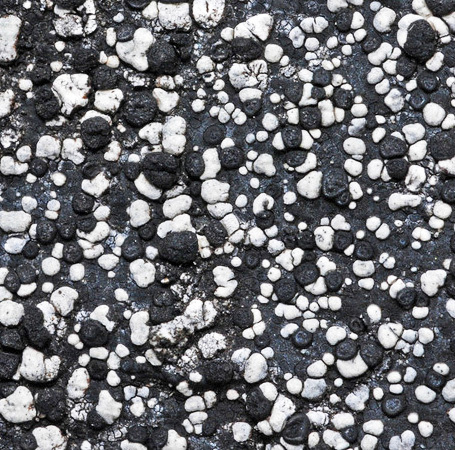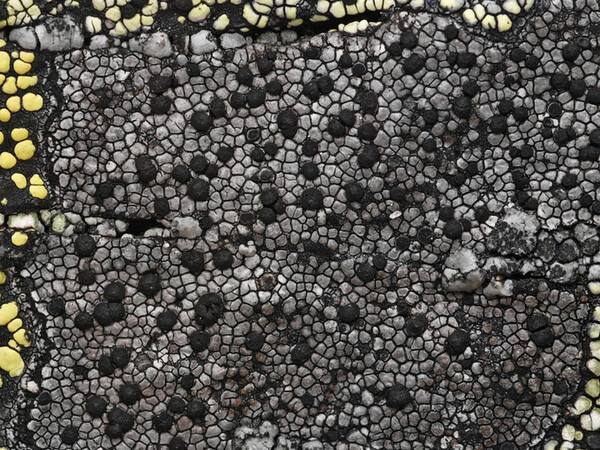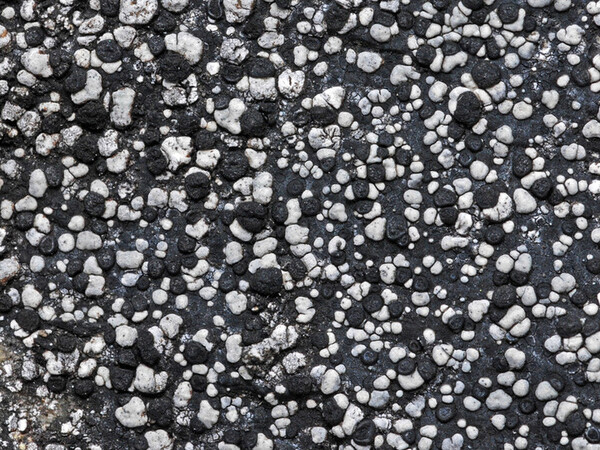Rhizocarpon copelandii (Körb.) Th. Fr.
Lichenogr. Scand., 2: 615, 1874. Basionym: Buellia copelandii Körb. - Zweite Deutsche Nordpolarfahrt, 2: 79, 1874.
Synonyms: Catocarpus badioater f. copelandii (Körb.) Eitner; Catocarpus copelandii (Körb.) Arnold; Rhizocarpon cyclodes Hellb. ex Th. Fr.; Rhizocarpon elevatum H. Magn.; Rhizocarpon hyperboreum (Vain.) Vain.
Description: Thallus crustose, episubstratic, areolate, very variable, from shade-forms with creamy white, 0.6-0.8(-1) mm wide, bullate areoles, to forms of sun-lit sites with grey to brown, flat areoles; black prothallus usually present. Medulla white, I-. Apothecia lecideine, black, to 0.7-1(-1.8) mm across, with a flat to convex disc and a persistent or more commonly soon excluded proper margin. Proper exciple poorly developed, dark brown in outer part, brown within, of radiating hyphae, K- or K+ red (red crystals); epithecium blue-black to green-black, with crystals insoluble in K, visible under polarized light, K-; hymenium colourless, 120-150 µm high; paraphysoids richly branched and anastomosing, c. 2.5-3 µm thick at mid-level, the apical cells scarcely swollen; hypothecium red-brown to brown-black. Asci 8-spored, disintegrating early, clavate, fissitunicate, with a well-developed tholus that is K/I- in lower part and K/I+ blue near the apex, lacking an ocular chamber, Rhizocarpon-type. Ascospores 1-septate, soon dark bluish black, ellipsoid, 18-35 x 9-15(-17) µm, halonate. Photobiont chlorococcoid. Spot tests: medulla K+ yellow turning red (acicular crystals) or K+ persistently yellow, C-, KC-, P+ yellowish or P+ orange. Chemistry: medulla with norstictic or stictic acid.
Growth form: Crustose
Substrata: rocks
Photobiont: green algae other than Trentepohlia
Reproductive strategy: mainly sexual
Commonnes-rarity: (info)
Alpine belt: very rare
Subalpine belt: extremely rare
Montane belt: absent
Dry submediterranean belt: absent
Humid submediterranean belt: absent
Padanian area: absent
pH of the substrata:
1 2 3 4 5
Solar irradiation:
1 2 3 4 5
Aridity:
1 2 3 4 5
Eutrophication:
1 2 3 4 5
Poleotolerance:
0 1 2 3
Altitudinal distribution:
1 2 3 4 5 6
Rarity
absent
extremely rare
very rare
rare
rather rare
rather common
common
very common
extremely common
Loading data...
Occurrence data
Predictive map
Growth form: Crustose
Substrata: rocks
Photobiont: green algae other than Trentepohlia
Reproductive strategy: mainly sexual
Commonnes-rarity: (info)
Alpine belt: very rare
Subalpine belt: extremely rare
Montane belt: absent
Dry submediterranean belt: absent
Humid submediterranean belt: absent
Padanian area: absent
pH of the substrata:
| 1 | 2 | 3 | 4 | 5 |
Solar irradiation:
| 1 | 2 | 3 | 4 | 5 |
Aridity:
| 1 | 2 | 3 | 4 | 5 |
Eutrophication:
| 1 | 2 | 3 | 4 | 5 |
Poleotolerance:
| 0 | 1 | 2 | 3 |
Altitudinal distribution:
| 1 | 2 | 3 | 4 | 5 | 6 |
Rarity
absent
extremely rare
very rare
rare
rather rare
rather common
common
very common
extremely common
Loading data...
Occurrence data
Predictive map









